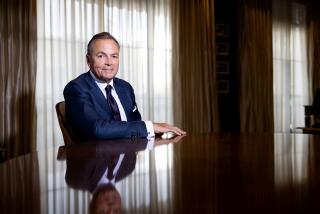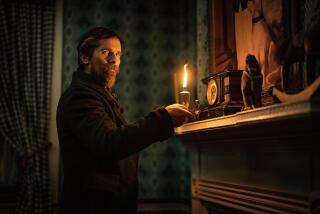As Big Brother watches, he’s watching back
Some writers encamp at coffee shops. Others lug their laptops to leafy parks or hushed university libraries. When D.J. Caruso came to Los Angeles, though, he found some of his best creative hours were spent amid the hustle and bustle of Union Station. Watching the parade of people with suitcases and train tickets spurred his imagination.
Caruso, whose latest film, a combustible thriller called “Eagle Eye,” opens Friday, recently returned to the din of the venerable depot, smiling as he watched the waves of arriving passengers, among them an elderly man in an electric-blue silk suit and a woman with twin boys, sullen and tethered by leashes like a pair of sad poodles.
He loves the architecture of this rambling edifice, as well as the fact that “Blade Runner” was shot here, “but my favorite thing is watching the people who get on and off trains, watching them greet each other,” the 43-year-old director said. “I would watch them and make up stories for them. Everyone is going from point A to point B. There are times when it gets quiet and then there’s a surge of people. Each person is a story, and I love thinking about that.”
Humble beginnings
Caruso IS writing his own Hollywood story now, and there have been quite a few plot twists. The Connecticut native got his start in town as an intern in the product placement division at Disney, which is not quite an elite academy for auteurs, but he ended up meeting director John Badham (“WarGames,” “Stakeout”), who became a major mentoring figure. Caruso worked on episodes of “Smallville” and “High Incident,” but his major breakthrough was “The Salton Sea,” the drugged-out 2002 neo-noir film that divided critics with its nihilism and squalor but established its young director as someone to watch.
The films that followed were mixed affairs, and Caruso is the first to admit it. There was “Taking Lives,” with Angelina Jolie on the trail of a serial killer, and “Two for the Money,” the gambling film starring Al Pacino. The big success was last year’s “Disturbia,” the suspense film that started a string of career-shaping roles for star Shia LaBeouf. The $18-million film pulled in $117 million worldwide, which led directly to Caruso and LaBeouf re-teaming for “Eagle Eye,” which has the young star portraying a man on the run from a shadowy government power that has framed him as a terrorist.
“It’s a big, fun popcorn movie, but it does have this underlying theme about our love for technology,” Caruso said. “We used to fear Big Brother, and now we’re inviting it into our life every day. We’ve opened up ourselves to be monitored and, in some ways, manipulated. And based on what I’ve been told by people at the Department of Defense and the FBI, there are already computer systems that are making decisions about us, about who we are and how we behave. So for me it’s great to have a movie that is fun, but it does have these messages beneath the surface. Someone told me today that ‘Eagle Eye’ is like ‘WarGames’ on steroids, and I really liked that.”
From idea to screen
Steven SPIELBERG is an executive producer of the film and came up with its central idea -- that every device around us that has a computer chip can be used as a weapon. LaBeouf’s character, along with a single mother played by Michelle Monaghan, essentially spends the whole film running for his life, sort of like the cast of the old Alfred Hitchcock film “The Birds,” except this time the chirping threats are cellphones, not pigeons.
“Steven had the idea about 10 or 12 years ago; he wrote it down but then sort of filed it away,” Caruso said, as he sipped coffee at a table next to Traxx, the station’s restaurant. “Steven saw technology would eventually reach this point. He is definitely a technophobe, which is interesting considering the films he’s made. A few years ago he tried to resurrect the movie.”
Early on, J.J. Abrams (of “Lost” and “Fringe” fame) worked on the script and mulled directing the film, as did Spielberg himself. There are four writers credited on the final script (Abrams is not among them), but Spielberg said Caruso was the strongest hand in the film.
“Sometimes a director has a take on a story that impresses the studio even as much as all his previous films,” Spielberg said. “That’s how I felt after hearing from D.J. when he read an early draft of ‘Eagle Eye.’ This movie was in his DNA.”
Perhaps, but considering the personalities involved and the path of the project, it’s reasonable to wonder how much of the final product truly reflects Caruso.
“It was a big, dynamic group, the A-list of the A-list; it took a number of people to crack this one, but I loved being in the middle of it,” Caruso said. “Really, my own apprehension was that the film would get so big and so spread out that it wouldn’t have my signature on it all the way through. The way I got the job was by coming in and saying that I wanted to keep the film very grounded in reality. The films that most inspired me as I looked at ‘Eagle Eye’ were ‘The French Connection’ and ‘The Parallax View.’ Steven lit up when I said that.”
Using famous films as a compass point is a natural shorthand in Hollywood, but it also raises a sore point for Caruso. The makers of “Disturbia” were named in a lawsuit this month that says the film was a rip-off of “Rear Window,” the revered 1954 Hitchcock classic. The suit wasn’t entirely shocking -- there didn’t seem to be a single major movie reviewer who didn’t mention that “Disturbia” felt like an unofficial remake of the old voyeur thriller -- but Caruso said he thought that the suit has no merit and that there is no real alarm among the defendants.
Early inspiration
“My FATHER was a great old Italian hairdresser who loved film,” Caruso said, “and Monday was our movie day. I remember going to see ‘Planet of the Apes’ at the drive-in and ‘Saturday Night Fever’ and ‘The French Connection.’
“I grew up in a little town, and those movies would just take me away. I remember when I was 16 and I had just got my license and I took this beautiful girl to see ‘E.T.’ and sitting there, watching her cry and trying not to cry myself, I think that is when I knew I had to be involved in the movie business.”
For the DVD commentary for “Eagle Eye,” Caruso sat down with his old mentor Badham and discussed the symmetry between the new film and “WarGames.” It was clearly a sweet moment for Caruso, and if the film does well at the box office, he will likely rise into a new strata in Hollywood. He’s already sizing up his next project, “Y: The Last Man,” an adaptation of Brian K. Vaughan’s comic book series about a plague that kills every man on Earth, except for one. LaBeouf is set to star in that one, suggesting that Caruso has clearly found his own on-screen muse.
Despite the successes, Caruso seems a bit unsure of himself. “After each film, I was sure my career was over, I was certain that I was going to have to look for something else as far as a career,” he said. “Sometimes I pinch myself now. I’m sitting at the same table as Steven Spielberg. But the trepidation is there. ‘Taking Lives’ had some moments, but it wasn’t well received, ‘Two for the Money’ wasn’t that well received. Filmmakers liked them, but critics didn’t, so you do find yourself worrying.”
Caruso pointed out some tall windows and spots at the train station used in “Blade Runner,” a movie he absolutely adores. He said he learned a lot by deconstructing that Ridley Scott film but that he has learned just as much from sitting through bad movies and studying their failing moments. It’s clear the father of five gets a lot of energy from anxiety.
“The thing that’s maddening for me is I never feel like I finish a movie, I just run out of time,” he said. “You send this child out into the world and you feel like you’re saying, ‘Good luck.’ It’s just torture to let it go. I’m a firm believer that you can’t tweak it too much; you only keep making it better.”
Getting ready to head out to see an IMAX screening of his new film, the director finished his coffee and scanned the crowd at the train station and said he would like to film a scene in the grand old building. “You feel the flow of the city here. It’s so not a Hollywood place. You feel like you can hear the ghosts talking. I really like that.”
--
More to Read
Only good movies
Get the Indie Focus newsletter, Mark Olsen's weekly guide to the world of cinema.
You may occasionally receive promotional content from the Los Angeles Times.










